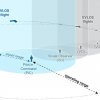Can't you use evlos or extended vlos, where partners equipped with radio follow the flight. see picture.
View attachment 103628
That has been a grey area in the US. 107.31 is self-contradictory on this.
§107.31 Visual line of sight aircraft operation.
(a) With vision that is unaided by any device other than corrective lenses, the remote pilot in command, the visual observer (if one is used), and the person manipulating the flight control of the small unmanned aircraft system must be able to see the unmanned aircraft throughout the entire flight in order to:
(1) Know the unmanned aircraft's location;
(2) Determine the unmanned aircraft's attitude, altitude, and direction of flight;
(3) Observe the airspace for other air traffic or hazards; and
(4) Determine that the unmanned aircraft does not endanger the life or property of another.
(b) Throughout the entire flight of the small unmanned aircraft, the ability described in paragraph (a) of this section must be exercised by either:
(1) The remote pilot in command and the person manipulating the flight controls of the small unmanned aircraft system; or
(2) A visual observer.
107.31(a) states that the RPIC, VO and pilot must
all be able to see the aircraft throughout the entire flight, but 107.31(b) states that either the pilot
or the VO are required to be able to see it.
Originally the FAA stated that the VO(s) must be co-located with the pilot and that the pilot, but I've seen more recent statements that confirm that the VO may be remote from the pilot provided that they have solid comms.
This provision only applies to Part 107 operations though - the recreational exception explicitly states that the VO must be co-located with the pilot.











